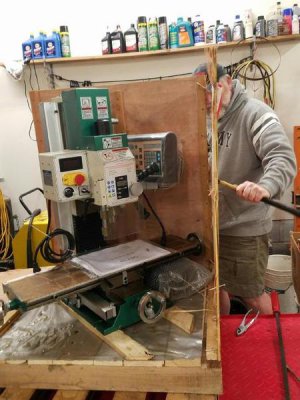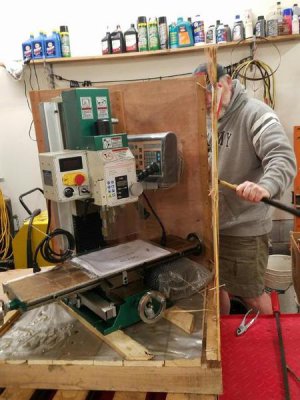- Joined
- Nov 23, 2014
- Messages
- 2,608
I do a fair amount of sheet metal work reproducing old Erector set parts from the 1920's - 1940's. My primary sheet metal working tools are a Tennsmith 37" shear, a Diacro 24" brake, a Roper Whitney #218 punch press, a HF 30" 3-in-1 sheet metal machine, a Dayton 2" x 42" belt sander and 4 or 5 Roper Whitney No. 5 hand punches. A few of the parts have inside corners that can't be cut with a straight shear, so I use an aviator snips and a lot of hand filing and/or belt sanding. It wasn't too hard to justify the purchase of a 4-ton notcher and 8" metal shear from Woodward Fab. Now, where to put it all . . .
You can see from the original work bench photo that it was full. The bench was a 30" x 60" 1 1/4" thick particle board top on a Grizzly 24" x 36" roll-around cart. I'll still keep the old bench around (can never have too many work benches). Today's POTD was to make a 36" x 72" work bench.
The top is 2 x 6's and one 2 x 4 which ended up at just a shade over 36" wide. I drilled 7/16" holes through the edge of the bench top boards on a drill press with an angle plate; could get 3 1/2" deep. Finished the drilling with a 7/16" augering bit. The boards are held together with a couple of 3' lengths of 3/8" all thread rod.
Apron around the top is 2 x 6's, apron around the bottom is 2 x 4's. The legs are tripled-up 2 x 6's. Casters are rated at 600 lbs. each (Menards). The bench top is a piece of 1/2" thick masonite (think Menards called in melamine). The masonite was screwed to the dimensional lumber top and trimmed on the edges to size with a router (edging bit). The bench is about 31" high which is perfect at my height for the Diacro brake. My old bench was about 36" high; I had to stand on a box to bend a 12" length of 1/8" aluminum at a 90.
Last couple of photos are with the bench top tools just setting in place. Still debating on the final layout before everything gets lagged down in place. I went with two fixed and two swivel casters, might be changing the two fixed ones to swivels for easier moving around in my crowded shop.
Bruce
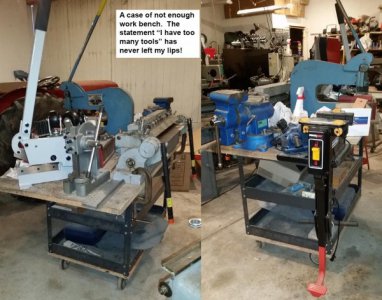
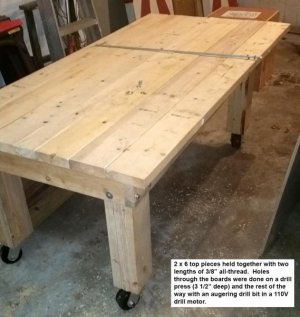
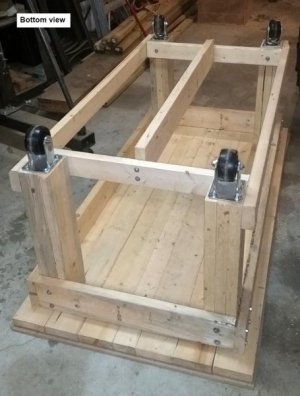
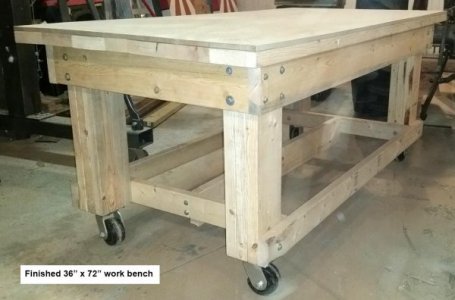
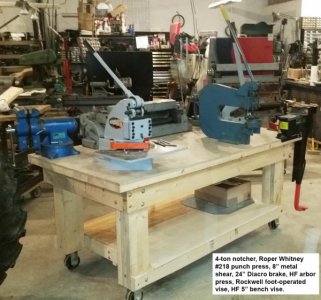
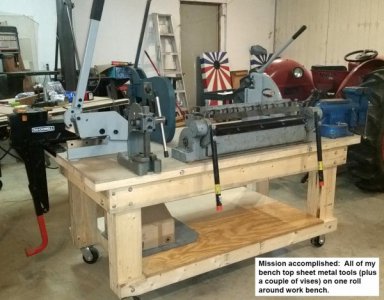
You can see from the original work bench photo that it was full. The bench was a 30" x 60" 1 1/4" thick particle board top on a Grizzly 24" x 36" roll-around cart. I'll still keep the old bench around (can never have too many work benches). Today's POTD was to make a 36" x 72" work bench.
The top is 2 x 6's and one 2 x 4 which ended up at just a shade over 36" wide. I drilled 7/16" holes through the edge of the bench top boards on a drill press with an angle plate; could get 3 1/2" deep. Finished the drilling with a 7/16" augering bit. The boards are held together with a couple of 3' lengths of 3/8" all thread rod.
Apron around the top is 2 x 6's, apron around the bottom is 2 x 4's. The legs are tripled-up 2 x 6's. Casters are rated at 600 lbs. each (Menards). The bench top is a piece of 1/2" thick masonite (think Menards called in melamine). The masonite was screwed to the dimensional lumber top and trimmed on the edges to size with a router (edging bit). The bench is about 31" high which is perfect at my height for the Diacro brake. My old bench was about 36" high; I had to stand on a box to bend a 12" length of 1/8" aluminum at a 90.
Last couple of photos are with the bench top tools just setting in place. Still debating on the final layout before everything gets lagged down in place. I went with two fixed and two swivel casters, might be changing the two fixed ones to swivels for easier moving around in my crowded shop.
Bruce








